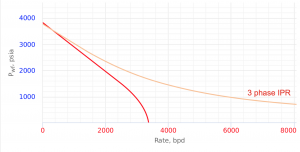Difference between revisions of "3 Phase IPR"
From wiki.pengtools.com
(→IPR calculator software) |
(→Nomenclature) |
||
| Line 47: | Line 47: | ||
== Nomenclature == | == Nomenclature == | ||
| − | + | ||
:<math> J </math> = productivity index, stb/d/psia | :<math> J </math> = productivity index, stb/d/psia | ||
:<math> J_D </math> = dimensionless productivity index, dimensionless | :<math> J_D </math> = dimensionless productivity index, dimensionless | ||
| Line 55: | Line 55: | ||
:<math> q </math> = flowing rate, stb/d | :<math> q </math> = flowing rate, stb/d | ||
:<math> S </math> = skin factor, dimensionless | :<math> S </math> = skin factor, dimensionless | ||
| − | |||
| − | |||
| − | |||
| − | |||
===Subscripts=== | ===Subscripts=== | ||
Revision as of 08:50, 11 April 2019
Contents
Three-phase Inflow Performance Relationship

3 Phase IPR Curve [1]
3 Phase IPR calculates IPR curve for oil wells producing water.
3 Phase IPR equation was derived by Petrobras based on combination of Vogel's IPR equation for oil flow and constant productivity for water flow [1].
3 Phase IPR curve is determined geometrically from those equations considering the fractional flow of oil and water [1].
Math and Physics
Total flow rate equations:
For Pb < Pwf < Pr
For pressures between reservoir pressure and bubble point pressure:
For PwfG < Pwf < Pb
For pressures between the bubble point pressure and the flowing bottom-hole pressures:
where:
For 0 < Pwf < PwfG
where:
And
3 Phase IPR calculation example
- PQplot nodal analysis software is used to calculate the IPR curves. PQplot is available online at www.pengtools.com.
- Excel
- other
Nomenclature
 = productivity index, stb/d/psia
= productivity index, stb/d/psia = dimensionless productivity index, dimensionless
= dimensionless productivity index, dimensionless = permeability times thickness, md*ft
= permeability times thickness, md*ft = pressure, psia
= pressure, psia = average reservoir pressure, psia
= average reservoir pressure, psia = flowing rate, stb/d
= flowing rate, stb/d = skin factor, dimensionless
= skin factor, dimensionless
Subscripts
- b = at bubble point pressure
- max = maximum
- o = oil
- test = well test
- wf = well flowing bottomhole pressure













